Teens and online social networks
Teens continue to be avid users of social networking websites – as of September 2009, 73% of online American teens ages 12 to 17 used an online social network website, a statistic that has continued to climb upwards from 55% in November 2006 and 65% in February 2008.
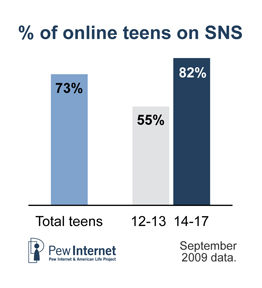
As we have seen consistently over time, older online teens are more likely to report using online social networks than younger teens. While more than 4 in 5 (82%) online teens ages 14-17 use online social networks, just a bit more than half of online teens ages 12-13 say they use the sites. These age findings are understandable in light of age restrictions on social networking sites that request that 12 year olds refrain from registering or posting profiles, but do not actively prevent it. Indeed, among online teens just 46% of 12 year olds in the study used social network sites, while 62% of 13 year olds used them.
Teens who go online daily are also more likely to use social network websites (or perhaps are encouraged by the sites to go online daily), with 80% of daily internet users visiting these sites compared with 62% of teens who go online less often. Teens from lower income families (those earning less than $30,000 annually) are more likely to use online social networks than teens from wealthier households, with more than four in five teens from the less well-off households using social networks compared to roughly 70% of teens from wealthier homes.
In November 2006, the composition of the teen social network-using population was somewhat different than it is today. There were no significant differences in family income between teen social network users and those who did not use the sites. Girls were more likely to use the sites than boys – unlike today when boys and girls are equally likely to visit. However, little has changed between 2006 and 2009 with regards to the age of social network users – then as now, 12 and 13 year old teens were much less likely to use online social network sites than their older, high-school aged counterparts.
Adults and social networks
Although the number of adults who use social networking websites has grown rapidly over the last several years, adults as a whole remain less likely than teens to use these sites. As of September 2009, 47% of online adults used a social networking website, compared with the 73% of teens who did so at a comparable point in time. The percentage of adults who use online social networks has grown from 8% of internet users in February 2005 to 16% in August 2006 to 37% in November 2008. On a typical day in 2009, just over one-quarter (27%) of adult internet users visited a social networking site.
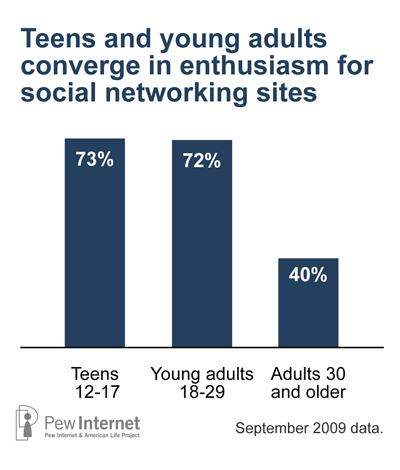
Just as with teens, usage of social networking websites by adults varies dramatically by age. Nearly three-quarters (72%) of online 18-29 year olds use these sites–similar to the rate among teens–with 45% doing so on a typical day. By contrast, 39% of internet users thirty and older use social networking websites. Within the under-thirty cohort, those ages 18-24 (73%) and those ages 25-29 (71%) are equally likely to use social networking sites. Men and women are equally likely to use these sites, as are whites, African-Americans and Hispanics. However, usage of online social networks among adults does vary by educational attainment—50% of online adults with at least some college experience use these sites, compared with 43% of such adults with a high school degree or less.
More adults on multiple social network sites
As the number of adults who use online social networks has grown, so has the percentage of social networking site users who maintain a profile on multiple sites. In May 2008, 54% of adults with a social networking site profile had a profile on just one site, while 29% had profiles on two sites and 13% had profiles on three or more sites.
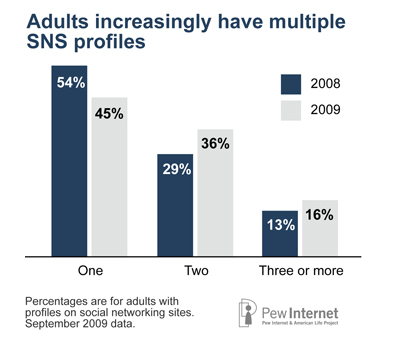
As of September 2009, the percentage of profile owners with only one profile had fallen by nine percentage points to 45%, while the percentage with two profiles had grown from 29% to 36% of profile owners. The proportion of social networking site users with profiles on three or more sites has remained consistent over this time period—16% currently have profiles on three or more such sites. Profile owners ages 18-29 are slightly more likely to have multiple profiles than those over thirty. Just under six in ten (57%) profile owners ages 18-29 maintain a profile on more than one site, compared with half (49%) of profile owners ages thirty and up.
Among adult profile owners, Facebook is currently the social network of choice; 73% of adult profile owners now maintain a profile on Facebook, 48% of all adult profile owners have a profile on MySpace and 14% of profile owners use LinkedIn as of September 2009.10
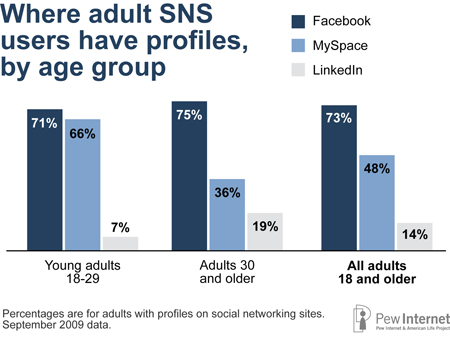
When it comes to use of specific social networking sites by different age cohorts, young adult profile owners stand out by being much more likely than those thirty and older to have a profile on MySpace. For adult profile owners under thirty, MySpace and Facebook are approximately equal in popularity, with LinkedIn a distant third—71% of profile owners between the ages of 18 and 29 have a profile on Facebook, 66% have a profile on MySpace and an additional 7% have a profile on LinkedIn. Three-quarters of profile owners ages thirty and older (75%) have a Facebook profile, similar to the figures for profile owners under thirty. However, MySpace is much less popular among older adults, as just 36% of profile owners in this age group have a profile on MySpace. LinkedIn, with its focus on professional networking, is also more widely used among profile owners thirty and older—19% of profile owners in this age group have a LinkedIn profile.
As with the usage of social networking sites in general, the specific sites on which adult users maintain their profiles also varies by educational attainment. Among adult profile owners with a high school degree or less, 64% have a profile on MySpace, 63% have a profile on Facebook and just 3% have a LinkedIn profile. Among profile owners with at least some college experience, Facebook and LinkedIn are much more popular—41% have a profile on MySpace, 78% have profile on Facebook and 19% have a LinkedIn profile. An analysis based on household income produces similar findings: compared with profile owners earning $50,000 or more per year, those with annual household incomes of less than $50,000 per year are significantly more likely to have a profile on MySpace (64% vs. 36%) and much less likely to have a profile on LinkedIn (6% vs. 22%). The proportion of high- and low-income profile owners with a profile on Facebook is similar—71% of profile owners earning less than $50,000 per year have a profile on Facebook, compared with 77% of those earning more than $50,000 per year.
Usage of different social networking sites also varies by gender and race. Among adult profile owners, men (18%) are more likely than women (10%) to maintain a profile on LinkedIn, while women (78%) are more likely than men (68%) to have a profile on Facebook. Additionally, white profile owners appear to gravitate towards Facebook and LinkedIn, while minority profile owners tend towards profiles on MySpace—however, due to the small number of minority profile owners in our September 2009 survey these differences are not presented in detail here.
Teens and social network communication practices
Even with teens’ continued enthusiasm for social networking, recent changes in their communication patterns on the sites suggest they are somewhat less tethered to their profiles. Teens have remained steady or even shown a slight decline in their likelihood of using social network sites to connect with friends. A bit more than a third (37%) of social network-using teens said they sent messages to friends every day through the social sites, a drop from the 42% of such teens who said they did so in February of 2008. Additionally, fewer teens are sending bulletins or group messages or sending private messages to friends from within social network sites. About half of teen social network users send group messages, down from 61% in 2006. And two-thirds of social network-using teens send private messages to friends, down from 82% in November 2006. Fewer teens are posting comments to a friend’s blog within a social networking site, with 52% of teens commenting on blogs, down from 76% in 2006. The decline in blog commenting in social networks may also reflect recent findings about the overall decline in blogging among teens.
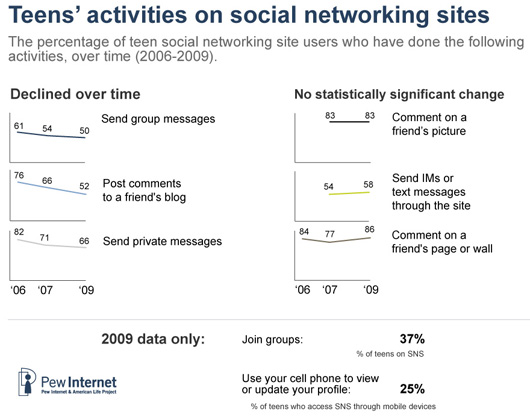
Posting comments, either to a picture, page or wall remains popular with teens who use social networks. Fully 86% of teen social network users post comments to a friend’s page or wall, and 83% have added comments to a friend’s picture. Sending instant messages or text messages to friends through a social network site has remained stable, with 58% of social networking teens saying they sent texts or IMs. Teens also join groups on social network sites – a bit more than a third (37%) say they have done so.
Twitter among teens and adults
There has been much media attention given to Twitter and other microblogging services over the past year and initially the supposition was that, as with other types of social network services, teenagers would be leading the adoption charge on a social, connective technology. However, data from September 2009 suggest that teens do not use Twitter in large numbers. While a September 2009 survey of adults suggests that 19% of adult internet users ages 18 and older use Twitter or update their status online,11 teen data collected at a similar time show that only 8% of online American teens ages 12-17 use Twitter.12

It should be noted that the question wording for teens is quite different from how the question was posed to adults so the results are not strictly comparable. For more on our adult findings about twitter, please see https://www.pewresearch.org/internet/Reports/2009/17-Twitter-and-Status-Updating-Fall-2009.aspx and https://www.pewresearch.org/internet/Reports/2009/Twitter-and-status-updating.aspx.
Older teens ages 14-17 are more likely to use Twitter than middle school teens ages 12-13. Among internet users, one in ten (10%) high school aged teens uses Twitter while less than half that number of younger teens – just 5% – do so. High school aged girls are driving the age differences; 13% of online girls in that age group use Twitter, compared to 7% of boys that age. Teens from households wired with broadband are slightly more likely to report using Twitter—with 9% of broadband users on Twitter compared to just 3% of teens with dial up access at home. There are no differences in Twitter use among teens by race, ethnicity or socioeconomic status.
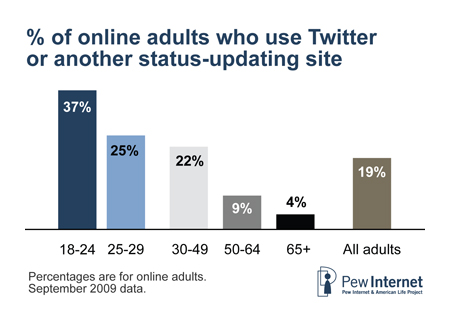
Among adults, young adults are the most active users of status update services such as Twitter; one-third (33%) of internet users under the age of thirty post or read status updates online. These services are especially popular among the youngest adults—fully 37% of online 18-24 year olds post status updates about themselves online or view the updates of others, up from 18% of the youngest adults in December 2008. These higher rates of Twitter use and status updating among young adults relative to teens may be partially due to our question wording capturing status updates on social networking sites. Many social networking sites offer the ability to post short status updates, and usage of social networking sites is highly correlated with status update behavior—fully 35% of social networking site users also post status updates online, compared with just 6% of internet users who do not use social networking websites. There is little variation in the use of status update services based on race, ethnicity or socio-economic status; however, online women (21% of whom use Twitter or other status update services) are more likely to use these services than men (17% of whom do so).
Adults, teens and virtual worlds
Virtual worlds are persistent online play spaces which allow users to determine the direction of game play. Teen use of virtual worlds has remained steady since February 2008 – currently, 8% of online teens say they visit virtual worlds like Gaia, Second Life or Habbo Hotel, similar to the 10% of such teens who visited virtual worlds in 2008. As we saw in 2008, younger teens continue to be more enthusiastic users of virtual worlds – 11% of online teens 12-13 use virtual worlds, while 7% of teen internet users 14-17 use them. There is no difference in virtual world use between boys and girls, by race or ethnicity or household income.
Use of virtual worlds is more common among teens than among adults. In September 2009 we measured virtual world usage among adults for the first time and found that 4% of online adults visit virtual worlds. Usage of virtual worlds is relatively consistent across age cohorts, with 4% of internet users under age 30 and 4% of those thirty and up visiting virtual worlds. Among adults there are no differences on virtual world use related to gender, race/ethnicity, income, or education.
Content Creation: Sharing, remixing, blogging, and more
In previous reports,13 we have highlighted teens who are avid and clever creators of digital content. Recent data suggests that some online content creating activities have remained constant over time, while others have shown slight or even significant declines since 2006. Adults, however, have shown some increases in content creating over the past few years, with most of the increases found among adults older than 30.
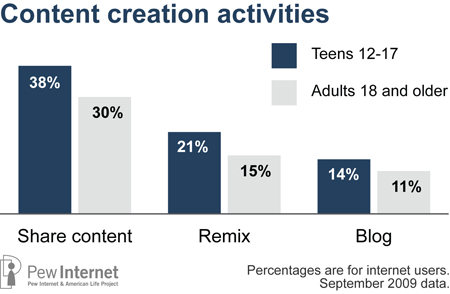
Sharing content
Teens share self-created content online like photos, videos, artwork or stories. Online sharing of content that teens have created themselves has remained steady since 2006; 38% of internet-using teens say they shared content online in 2009, similar to the 39% who said the same in November 2006. There is no variation among teens today in sharing self-created content by sex, age, race, ethnicity or socioeconomic status – all groups are equally likely to share. By comparison, in 2006, girls and older teens were more likely to share content online. Still, in 2006 and in 2009, there were no differences in sharing content by race, ethnicity, family income or parent’s education level.
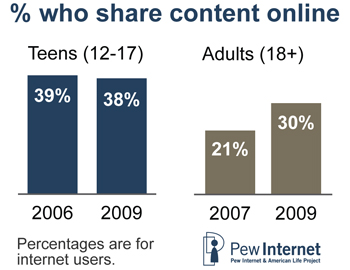
While creative content sharing among teens has not increased significantly since 2006, more adults now share self-created content online than did so two years ago. Three in ten online adults (30%) share online content as of September 2009, up from 21% of such adults in December 2007. Interestingly, almost none of this growth over time has come from young adults. Thirty-seven percent of online 18-29 year olds now share their personal creations online, a figure that is unchanged from the 36% who did so in 2007. In contrast, 28% of internet users ages thirty and up now take part in this activity, a twelve-point increase from the 16% who did so in 2007.
There are no major differences in online content sharing among adults based on gender or race/ethnicity, although there is some variation based on educational attainment. One-third (34%) of internet users with at least some college experience post their own creations online, compared with one-quarter (24%) of those with a high school degree or less.
Remixing
As with content sharing, teens have held steady in their reports of remixing online content – taking material they find online such as songs, text or images and remixing it into their own artistic creations. About one in five online teens (21%) report remixing digital content, which is not a statistically meaningful difference from our previous finding that 26% of teens reported remixing in November 2006. Girls are more likely to remix content than boys, with one quarter (26%) of online girls remixing online material compared to 15% of boys. Younger boys are the least likely to remix content – just 9% of online boys ages 12-13 remix. Remixing shows no variation by race, income or parent’s level of education. Remixing in 2006 showed similar patterns to 2009, with the only difference being that boys and girls were equally likely to report remixing content in 2006.
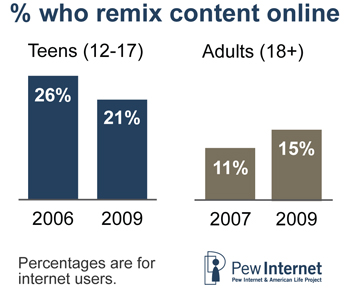
Among online adults, 15% take part in remix culture—and as with online content sharing, remixing has grown somewhat in popularity among older adults over the last two years and not at all among young adults or teens. One in five (19%) online 18-29 year olds remixes content they find online (unchanged from the 20% who did so in late 2007), while 13% of internet users ages thirty and up do so (a five percentage point increase from the 8% who did so in 2007). In contrast to teens, among adults, men and women are equally likely to remix content. There is little variation among adults based on race/ethnicity or socio-economic status.
Blogging
Among all the content creating activities discussed here, most striking is the decline in blogging among teens and young adults. Since 2006, blogging by teens has dropped from 28% of teen internet users to 14% of online teens in 2009.

Teens are now beginning to resemble their elders in their likelihood of blogging, as about 12% of adults have consistently reported blogging since February 2007. This decline is also reflected in the decline of the number of teens who say they comment on blogs within social networking websites – 52% of social network-using teens report commenting on friends’ blogs within these sites, down from 76% commenting in 2006 (as discussed earlier in this report.) Continuing a trend in teen blogging that first emerged in 2006, teens from lower income families – those earning below $50,000 annually — are more likely to report keeping a blog than teens from households earning more than $50,000. While 23% of online teens from families earning less than $50,000 per year keep a blog, just 8% of teens from households earning more than $50,000 a year say they keep a blog. Unlike in years past, boys and girls are statistically just as likely to keep a blog. There are no racial or ethnic differences in blogging by teens.
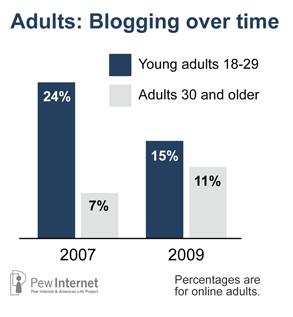
This decline in teen blogging mirrors a similar decrease in blogging activity among the youngest adult internet users. In December 2007, fully 28% of online 18-24 year olds maintained a blog. By September 2009 that figure had fallen by half, and just 14% of internet users ages 18-24 maintained a blog. Despite this decline among young adults, the proportion of all adult internet users who blog has not budged over this same time period (12% of adult internet users did so in 2007, and 11% do so now).
The prevalence of blogging among adults as a whole has remained consistent because the decline in blogging among young adults has been marked by a corresponding increase in blogging among older adults. For example, in December 2007, 24% of online 18-29 year olds reported blogging, compared with 7% of those thirty and older. By 2009, that difference had nearly disappeared—15% of internet users under age thirty and 11% of those ages thirty and up now maintain a personal blog. Among adult internet users, blogging is equally common among men and women; whites, black and Hispanics; and those with low and high levels of income and education.
Additional Adult Content Creation Activities
Along with the content creation activities analyzed above, our September 2009 survey asked adult internet users about three additional content creation activities that were not asked of teens. These activities include: creating or working on a personal webpage; creating or working on a webpage or blog belonging to someone else (such as friends, groups, or for work); and posting comments to an online news group, website, blog or photo site.
Building websites
The proportion of adults who create or work on a website (either a personal site, or someone else’s) has remained consistent over the last two years. Fourteen percent of online adults maintain a personal webpage (unchanged from the 14% who did so in December 2007), while 15% work on the webpages of others (also unchanged from the 13% who did so in December 2007).
Adult internet users under age thirty are more likely than those ages thirty and up to work on a personal webpage (18% vs. 13%) as well as to work on a webpage for someone else (21% vs. 13%). Within the under-thirty cohort, those ages 18-24 and those 25-29 are equally likely to work on webpages of any kind. Men are more likely than women to work on their own webpage (16% of online men do so, compared with 12% of online women) as well as to work on webpages for others (17% vs. 12%).
Posting comments
Posting comments online (such as on a news group, website, blog or photo site) has become somewhat more common among adults over the last two years. Just over one-quarter (26%) of wired adults posted comments online as of September 2009, up from 22% of such adults in late 2007. As with many of the content creation activities discussed here, those under age thirty are no more likely to post online comments in 2009 then they were in 2007, while for older adults commenting has become more popular in recent years. In 2009 33% of internet users ages 18-29 posted comments online (unchanged from the 35% who did so in December 2007). Among internet users ages thirty and up, one-quarter (24%) now post comments online, up from 18% in late 2007. As reported earlier, teens are enthusiastic online commenters within the social network context. Fully 86% of social-networking teens post comments to a friend’s page or wall on a social network site and 83% post comments on friends’ photos posted to an online social network.
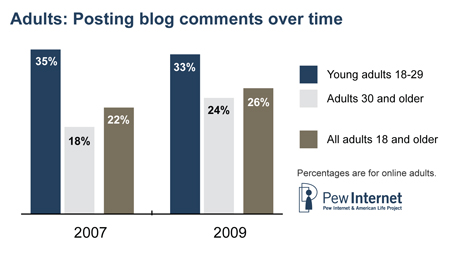
There is little variation in online commenting by adults based on gender, race/ethnicity or income. However, education does play a role—31% of adult internet users with at least some college experience post comments online, significantly higher than the 20% of those with a high school degree or less who do so.




